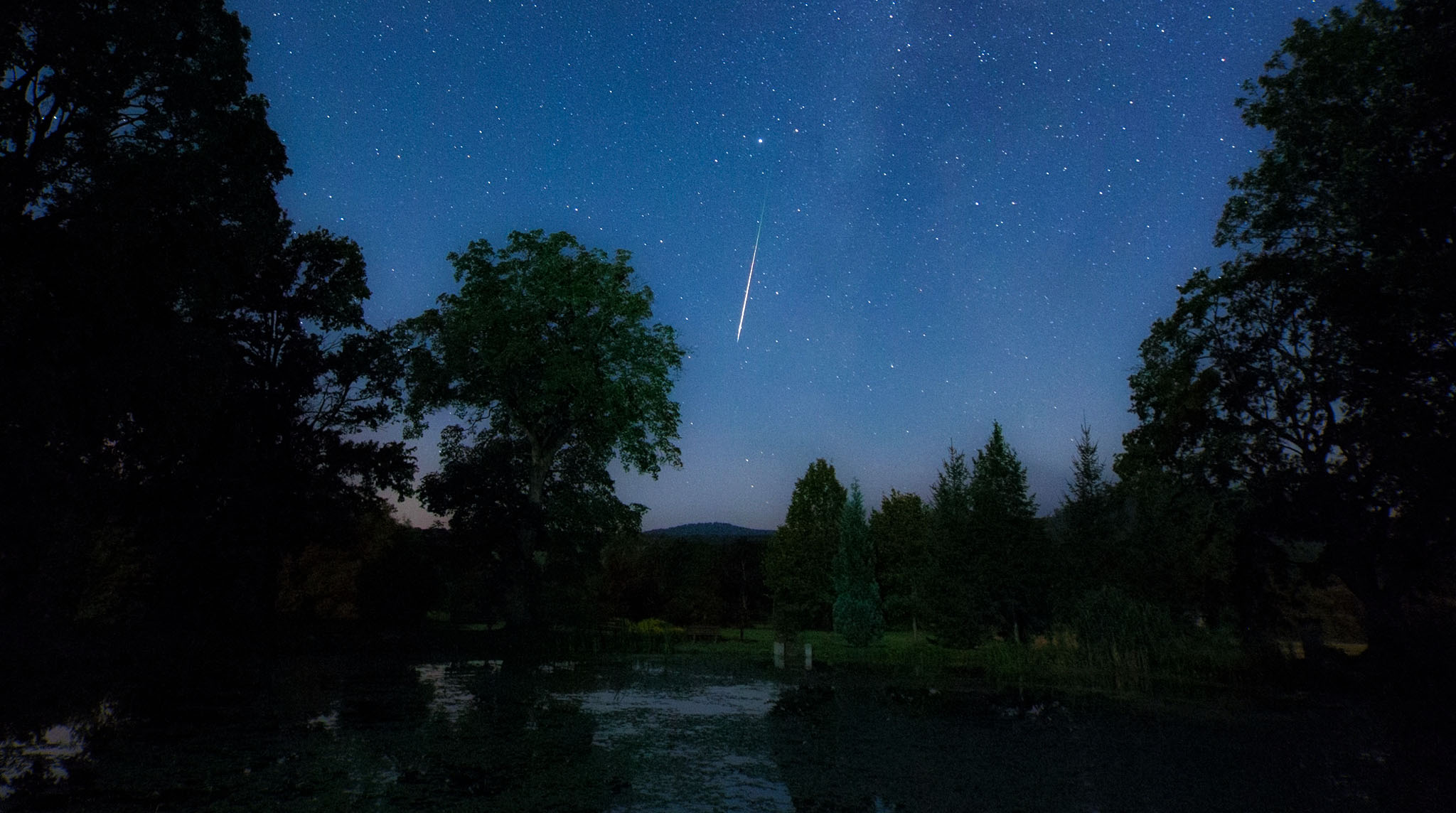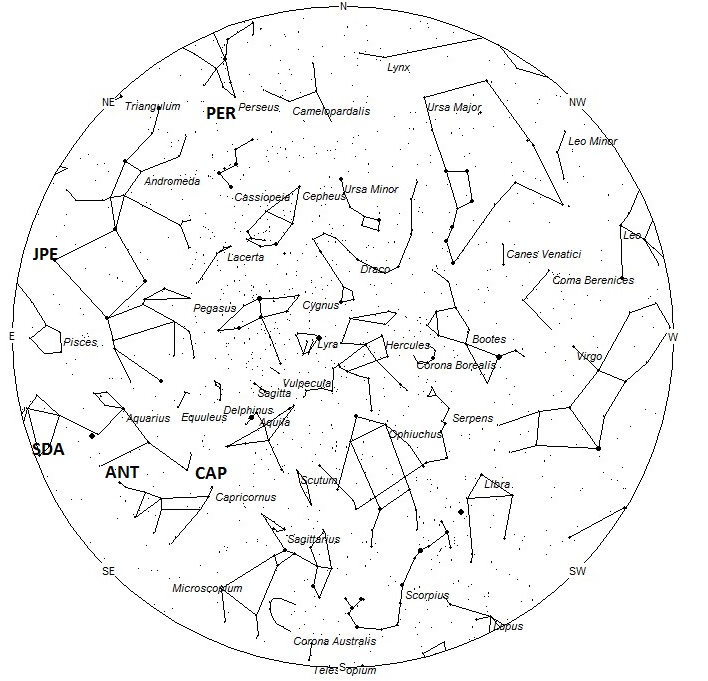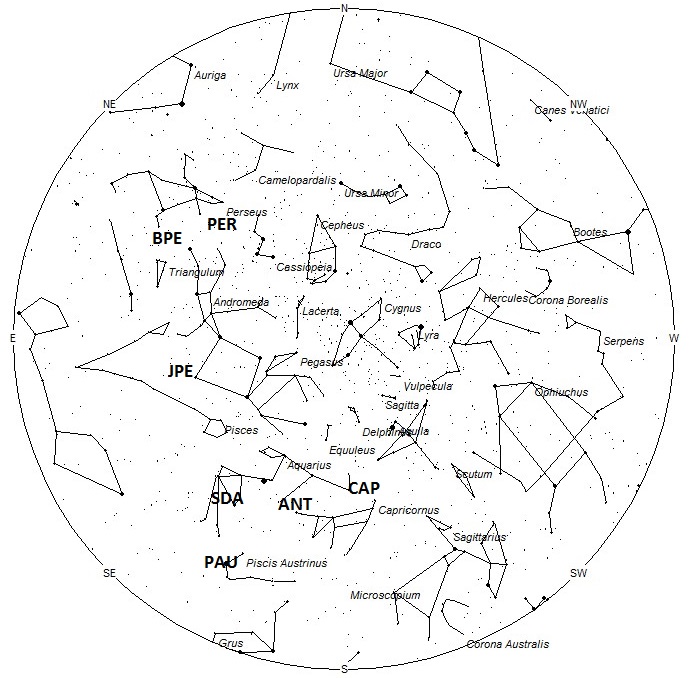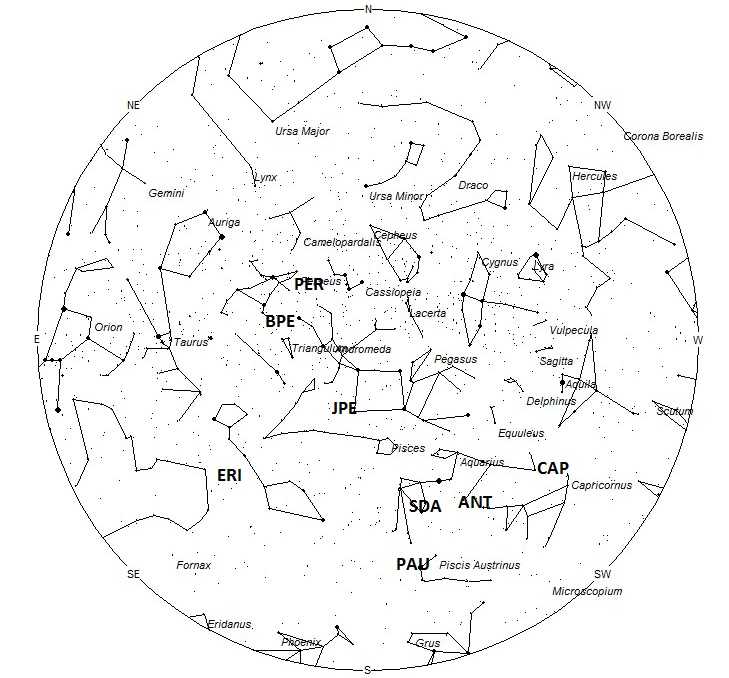
A meteor from the Perseid meteor shower – Hungary, August 2012 © Tamas Ladanyi, Twan
Meteor activity kicks into high gear in August as seen from the northern hemisphere. The main reason for all this activity is the Perseid shower that peaks on August 13th. This shower is active most of the month and remains above the level of the sporadic background for a week centered on August 13th. The sporadic activity is also near maximum as seen from the northern hemisphere and is now more than double the rates from just three months ago. As seen from southern hemisphere, meteor rates are still decent but falling rapidly. The sporadic rates continue their downward slide and the Perseid radiant does not rise high into the sky as seen in the southern hemisphere. So rates for the Perseids are greatly reduced when compared to those seen from the northern hemisphere.
During this period the moon reaches its last quarter phase on Friday August 7th. At this time the moon is located 90 degrees west of the sun and rises near midnight local daylight savings time (LDT). This weekend the waning gibbous moon will rise during the early evening hours and will spoil viewing conditions the remainder of the night. In these conditions it will be difficult to view meteor activity unless your skies are transparent. Later in the week, as the moon approaches its half phase, conditions will be far more favorable to view meteor activity. The estimated total hourly meteor rates for evening observers this week is near 3 for viewers at mid-northern latitudes (45N) and 2 for those located at southern tropical latitudes (25S). For morning observers the estimated total hourly rates should be near 11 for viewers at mid-northern latitudes (45N) and 9 for those located at southern tropical latitudes (25S). The actual rates will also depend on factors such as personal light and motion perception, local weather conditions, alertness and experience in watching meteor activity. Overall rates during this period are reduced due to bright moonlight. Note that the hourly rates listed below are estimates as viewed from dark sky sites away from urban light sources. Observers viewing from urban areas will see less activity as only the brightest meteors will be visible from such locations.
The radiant (the area of the sky where meteors appear to shoot from) positions and rates listed below are exact for Saturday night/Sunday morning August 1/2. These positions do not change greatly day to day so the listed coordinates may be used during this entire period. Most star atlases (available at science stores and planetariums) will provide maps with grid lines of the celestial coordinates so that you may find out exactly where these positions are located in the sky. A planisphere or computer planetarium program is also useful in showing the sky at any time of night on any date of the year. Activity from each radiant is best seen when it is positioned highest in the sky, either due north or south along the meridian, depending on your latitude. It must be remembered that meteor activity is rarely seen at the radiant position. Rather they shoot outwards from the radiant so it is best to center your field of view so that the radiant lies at the edge and not the center. Viewing there will allow you to easily trace the path of each meteor back to the radiant (if it is a shower member) or in another direction if it is a sporadic. Meteor activity is not seen from radiants that are located below the horizon. The positions below are listed in a west to east manner in order of right ascension (celestial longitude). The positions listed first are located further west therefore are accessible earlier in the night while those listed further down the list rise later in the night.
These sources of meteoric activity are expected to be active this week. Details on each source will return next week when moonlight conditions will be far more favorable.
| SHOWER | DATE OF MAXIMUM ACTIVITY | CELESTIAL POSITION | ENTRY VELOCITY | CULMINATION | HOURLY RATE | CLASS |
| RA (RA in Deg.) DEC | Km/Sec | Local Daylight Time | North-South | |||
| Alpha Capricornids (CAP) | Jul 27 | 20:32 (308) -09 | 22 | 01:00 | 1 – 1 | II |
| Anthelions (ANT) | – | 21:24 (321) -13 | 29 | 02:00 | 1 – 2 | II |
| Delta Aquariids (SDA) | Jul 29 | 22:56 (344) -15 | 42 | 03:00 | 1 – 2 | I |
| Piscids Austrinids (PAU) | Jul 28 | 23:04 (346) -30 | 35 | 03:00 | <1 – <1 | II |
| July Pegasids (JPE) | Jul 10 | 00:24 (006) +16 | 68 | 04:00 | <1 – <1 | IV |
| Perseids (PER) | Aug 13 | 02:08 (032) +55 | 61 | 05:00 | 3 – 1 | I |
| Eta Eridanids (ERI) | Aug 05 | 02:30 (038) -14 | 66 | 06:00 | <1 – <1 | IV |
| Beta Perseids (BPE) | Aug 07 | 02:35 (039) +39 | 61 | 06:00 | <1 – <1 | IV |
 American Meteor Society
American Meteor Society


